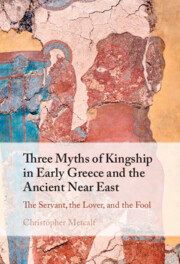Refine search
Actions for selected content:
68 results
4 - Potnia of the Labyrinth, Initiation of the King, and the Triple Sacrifice
-
- Book:
- Myth, Ritual, and Society in Mycenaean Anatolia
- Published online:
- 18 July 2025
- Print publication:
- 07 August 2025, pp 131-161
-
- Chapter
- Export citation
2 - Mycenaean and Vedic Sacrificial Posts
-
- Book:
- Myth, Ritual, and Society in Mycenaean Anatolia
- Published online:
- 18 July 2025
- Print publication:
- 07 August 2025, pp 47-66
-
- Chapter
- Export citation
6 - Nart Saga, Indo-Iranian Twins, and Dioscurias
-
- Book:
- Myth, Ritual, and Society in Mycenaean Anatolia
- Published online:
- 18 July 2025
- Print publication:
- 07 August 2025, pp 194-237
-
- Chapter
- Export citation
7 - Golden Fleeces
-
- Book:
- Myth, Ritual, and Society in Mycenaean Anatolia
- Published online:
- 18 July 2025
- Print publication:
- 07 August 2025, pp 238-272
-
- Chapter
- Export citation
1 - A Mycenaean Ritual and Its Cult Language
-
- Book:
- Myth, Ritual, and Society in Mycenaean Anatolia
- Published online:
- 18 July 2025
- Print publication:
- 07 August 2025, pp 8-46
-
- Chapter
- Export citation
3 - Mycenaean Leaders in the Context of Indo-European and Indo-Iranian Society and Ritual
-
- Book:
- Myth, Ritual, and Society in Mycenaean Anatolia
- Published online:
- 18 July 2025
- Print publication:
- 07 August 2025, pp 67-130
-
- Chapter
- Export citation

Three Myths of Kingship in Early Greece and the Ancient Near East
- The Servant, the Lover, and the Fool
-
- Published online:
- 19 December 2024
- Print publication:
- 02 January 2025
Chapter 3 - Vergil’s Ecological Poem
-
- Book:
- The Environmental Poetry of Augustan Rome
- Published online:
- 12 December 2024
- Print publication:
- 19 December 2024, pp 98-145
-
- Chapter
- Export citation
8 - A Brief History of Epic Time
- from Part III - Epic Time
-
-
- Book:
- The Cambridge Companion to Ancient Greek Epic
- Published online:
- 04 December 2024
- Print publication:
- 28 November 2024, pp 169-183
-
- Chapter
- Export citation
3 - Didactic (and) Epic
- from Part I - Epic Engagements
-
-
- Book:
- The Cambridge Companion to Ancient Greek Epic
- Published online:
- 04 December 2024
- Print publication:
- 28 November 2024, pp 58-78
-
- Chapter
- Export citation
6 - Epic Dislocation
- from Part II - Epic Space
-
-
- Book:
- The Cambridge Companion to Ancient Greek Epic
- Published online:
- 04 December 2024
- Print publication:
- 28 November 2024, pp 130-146
-
- Chapter
- Export citation
1 - Greek and Near Eastern Epic
- from Part I - Epic Engagements
-
-
- Book:
- The Cambridge Companion to Ancient Greek Epic
- Published online:
- 04 December 2024
- Print publication:
- 28 November 2024, pp 17-40
-
- Chapter
- Export citation
5 - Do Not Talk Death to Me
- from Part II - Epic Space
-
-
- Book:
- The Cambridge Companion to Ancient Greek Epic
- Published online:
- 04 December 2024
- Print publication:
- 28 November 2024, pp 104-129
-
- Chapter
- Export citation
11 - Asian Goddesses and Bees
- from Part III - Anatolian and Aeolian Myth and Cult
-
- Book:
- Aeolic and Aeolians
- Published online:
- 21 November 2024
- Print publication:
- 21 November 2024, pp 317-343
-
- Chapter
- Export citation
10 - Boeotian Foundation Mûthoi: From Dioscuri to Cabiri
- from Part II - Aeolian Origins in Myth
-
- Book:
- Aeolic and Aeolians
- Published online:
- 21 November 2024
- Print publication:
- 21 November 2024, pp 277-314
-
- Chapter
- Export citation
Chapter 5 - To Educate and to Entertain: Didactic and the Arrangement of Knowledge
-
- Book:
- A History of Latin Literature From its Beginnings to the Age of Augustus
- Published online:
- 14 November 2024
- Print publication:
- 21 November 2024, pp 148-197
-
- Chapter
- Export citation
17 - Conclusion
- from Part III - Anatolian and Aeolian Myth and Cult
-
- Book:
- Aeolic and Aeolians
- Published online:
- 21 November 2024
- Print publication:
- 21 November 2024, pp 519-552
-
- Chapter
- Export citation
15 - Honey and Theogonies: The West Face of Sipylus
- from Part III - Anatolian and Aeolian Myth and Cult
-
- Book:
- Aeolic and Aeolians
- Published online:
- 21 November 2024
- Print publication:
- 21 November 2024, pp 450-481
-
- Chapter
- Export citation
13 - Aia and Argonauts
- from Part III - Anatolian and Aeolian Myth and Cult
-
- Book:
- Aeolic and Aeolians
- Published online:
- 21 November 2024
- Print publication:
- 21 November 2024, pp 375-409
-
- Chapter
- Export citation
6 - Pindar, Bacchylides, Archaic Epic, and Intertextuality
- from Part II - Lyric and Epic
-
-
- Book:
- Texts and Intertexts in Archaic and Classical Greece
- Published online:
- 14 November 2024
- Print publication:
- 21 November 2024, pp 138-166
-
- Chapter
- Export citation
